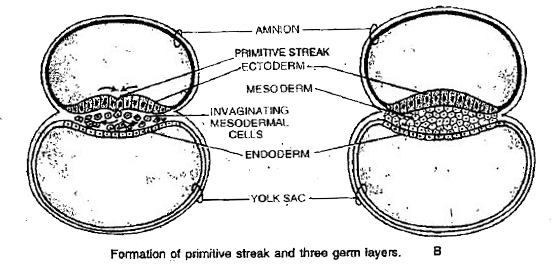Describe the formation and fate of three germlayers inamammalian embryo.Solution in Punjabi
Formation of Germs layers/Embryonic Layers. After the formation of the primitive streak, cells of the epiblast move invward:below the primitive streak and detach from the epiblast. This inverting movement is called invagination. (i) Once the cells have invaginated, some of them displace the hypoblast forming the endoderm. Endoderm develops first during embryonic development. (ii) Other cells remain between the epiblast and newly formed endoderm forms the mesoderm: (iii) Cells remaining in the epiblast form ectoderm.

These three germ layers i.e., ecto, meso and endoderm form all the tissues and organs of the body.
Fate of Germ Layers in mammalian embryo. Each germ layer gives rise to the specific issues, organs and organ-systems.
1. Ectoderm. It gives rise to (i) epidermis of skin, and epidermal derivatives (glands, hair, lails), (ii) nervous system, (iii) medulla of adrenal gland, posterior and intermediate lobes of pituitary gland, pined gland (iv) eye (conjunctiva, cornea, lens, retina, iris and ciliary muscles), (v) internal ear, (vi) nasa epithelium, (vii) lining of stomodaeum and proctodaeum, (viii) lining of external aucutory canal, (ix) lacnmal glands, salivary glands, and (x) enamel of teeth. 2. Mesoderm. It produces (i) dermis of skin, (ii) most muscles, connective tissues, (iii) peritoneum, (iv) kidneys, (v) cortex of adrenal glands, (vi) gonads, (vii) urinary and reproductive ducts, (viii) heart blood and lymph vessels, (ix) spleen (x) wall of gut except its lining epithelium. (xi) pericardium and pleura, (xii) sclera and choroid of eye, (xiii) most of skeleton, (xiv) dentine of teeth, (xv) mesenteries, and (xvi) notochord. 3. Endoderm. It forms (i) lining of gut except that of stomodaeum and proctodaeum, (ii. gastric and intestinal glands, tongue epithelium, liver, pancreas, anterior lobe of pituitary gland. thyroid gland, parathyroid glands, thymus gland, (iii) lining of trachea, bronchi and lungs, (iv) lining of urinary bladder, (v) lining of middle ear, (vi) primordial germ cells, and (vii) greater part of prostate.
Topper's Solved these Questions
- HUMAN REPRODUCTIONBOOK - BETTER CHOICE PUBLICATIONCHAPTER - HUMAN REPRODUCTIONEXERCISE - SHORT ANSWER TYPE QUESTIONS (MOAT EXPECTED QUESTIONS)
3 Videos
- HUMAN HEALTH AND DISEASEBOOK - BETTER CHOICE PUBLICATIONCHAPTER - HUMAN HEALTH AND DISEASEEXERCISE - LONG ANSWER TYPE QUESTIONS (MOST EXPECTED QUESTIONS)
12 Videos
- MICROBES IN HUMAN WELFAREBOOK - BETTER CHOICE PUBLICATIONCHAPTER - MICROBES IN HUMAN WELFAREEXERCISE - LONG ANSWER TYPE QUESTIONS (MOST EXPECTED QUESTIONS)
2 Videos
Similar Questions
What is role played by luteinizing hormone in males and females?
View SolutionWrite the causative organism, mode of infection, symptoms and preventive measures of the disease pertussis.
View SolutionExplain the role of microbes in the treatment of sewage.
View SolutionState the fate of a pair of autosomes during gamete formation.
View SolutionDescribe the process of megasporogenesis upto fully developed embryo sac formation in an angiosperm.
View SolutionDescribe the fate of an unfertilized and a fertilized egg of honeybee.
View SolutionDescribe the formation of three germ layers in a mammalian embryo .
View SolutionDescribe the process of embryo formation.
View SolutionWhat is Spermatogenesis ? Explain the process of spermatogenesisi.
View SolutionDescribe the process of spermatogenesis upto the formation of spermatids. Mention the fate of spermatids.
View SolutionWhat is the fate of pollen tube after reaching the embryo sac?
View SolutionWhat is the fate of trophoblast in mammalian embryo?
View SolutionExplain the formation and fate of primary layers in the human embryo.
View SolutionState the fate of a pair of autosomes during gamete formation.
View SolutionDescribe the process of megasporogenesis upto fully developed embryo sac formation in an angiosperm.
View SolutionDescribe the formation and fate of three germlayers inamammalian embryo.
View Solution
